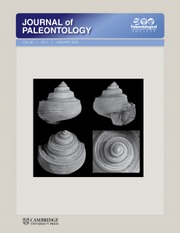No CrossRef data available.
Article contents
Simulations of evolutionary radiations and their application to understanding the probability of a Cambrian explosion
Published online by Cambridge University Press: 20 May 2016
Abstract
A molecular survey of animal phylogeny (Wray et al., 1996) recovered the presumed correct temporal order of the phylogenetic splits Protostomata-Deuterostomata, Echinodermata-Chordata, and Agnatha-Gnathostomata in studies of six of seven gene sequences. This result raised the question of how this order could be recovered if all of the phyla had appeared in a Cambrian “explosion” of less than 10 m.y., given the expected erratic nature of the molecular “clock.” We simulated trees, and molecular sequence evolution along the trees, under different evolutionary radiation scenarios, with different periods of radiation, relative to times of subsequent evolution. Simulations and phylogenetic analyses of sequences derived from a simulated “Cambrian explosion” of 10–35 million years did not allow the successful recovery of the correct tree, using neighbor-joining, maximum likelihood, or parsimony methods. Success in recovering phylogenies under a Cambrian divergence scenario (520 million years ago) did not exceed 80 percent without an extended divergence time interval of at least 100 m.y. An increased substitution rate during the initial radiation improved the ability to recover correct phylogenies, especially when the rate was 8–10 times the rate following the radiation. Our results militate against the likelihood of an Early Cambrian or slightly longer explosion of the animal phyla, as apparently supported by the fossil record. Some limitations to these conclusions are discussed.
Information
- Type
- Selected Papers from the Sixth North American Paleontological Convention
- Information
- Copyright
- Copyright © The Paleontological Society

